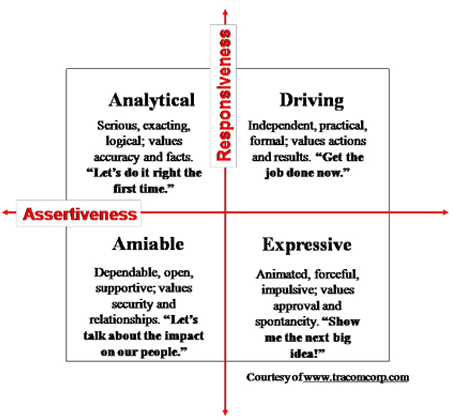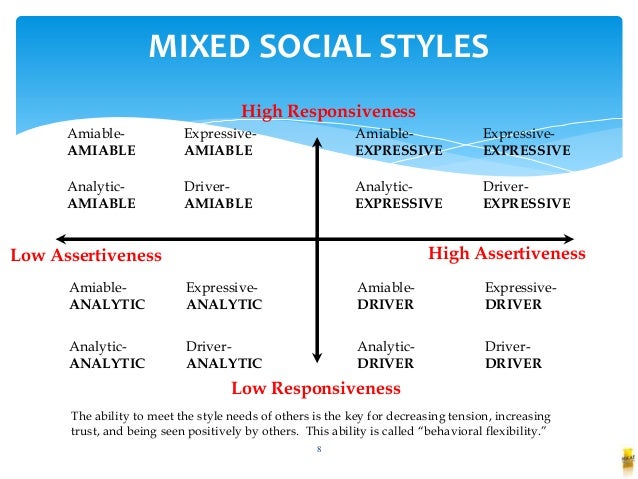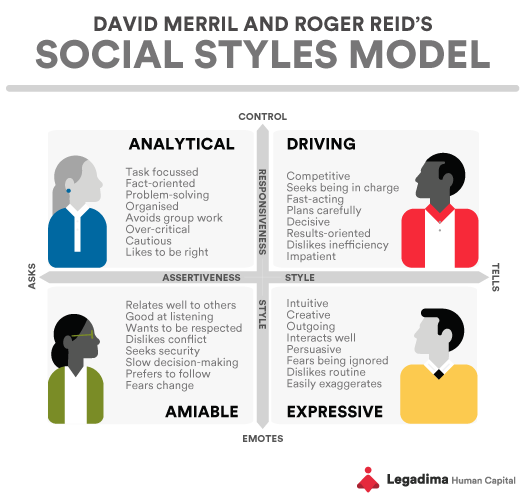There are four major behavioral styles: analytical, amiable, driver and expressive. Please note that I am using an extreme simplification of each particular style. It is doubtful that all people of a particular behavioral style exhibit all of the characteristics portrayed. The Four SOCIAL STYLES are the Driving Style, the Expressive Style, the Amiable Style, and the Analytical Style. TRACOM created the SOCIAL STYLE Model based on the four unique Styles, with each having different ways of using time and predictable ways of interacting and making decisions. With the SOCIAL STYLES assessment, you can observe a.
Explanations > Preferences > Social Styles

Assertiveness | Responsiveness | Driver | Expressive | Amiable | Analytical | So what?
Social Style Theory is based on work originated by David Merrill, who used factor analysis to identify two scales, identified as assertiveness and responsiveness. This results in a model that has four quadrants which identify four social styles. There has been much commentary and various use of this model. Here are notes and comments.
Assertiveness
In social interaction it is common for people to want things from others. In making requests they may be highly assertiveness or they may make requests at a lower, even passive level.
This dimension is sometimes also called 'dominance'.
High assertiveness

A highly assertive person is likely to tell others or demand things that they want rather than asking or not saying anything.
People who prefer using higher levels assertiveness are more likely to face up to difficulties rather than avoiding them. They have a higher confidence in themselves and believe they have the right to demand what they need. They may see life as 'dog eat dog' and that they must fight for what they want, which makes them more competitive and ready to act quickly and take risks.
In the social styles grid, high assertiveness typically has the label 'Tells'.
Low assertiveness
In low assertiveness, a person who wants something from another is likely to ask rather than demand or tell. If they are particularly passive, they may not even ask, avoiding what may be perceived as possible conflict. Likewise, they tend to avoid risks, which may be an even deeper cause than low assertiveness. Being slower than the competitive high-assertives they tend to be more inquisitive and collaborative.

People may have lower assertiveness for several reasons, for example a self-based fear of social criticism or perhaps an other-based fear, disliking the idea of embarrassing or distressing others. They may have been taught when young that one should not push oneself forward.
In the social styles grid, low assertiveness typically has the label 'Asks'.
Responsiveness
Whilst assertiveness has to do with communicating to others, responsiveness is about how the person responds to the requests or demands of others on them.
This dimension is sometimes also called 'sociability' or (in reverse) 'task focused'.
High responsiveness
A person with higher responsiveness has a higher emotional response to others. This may appear as empathy although it may simply be that they have less control over their own emotions and react in an emotional way. They are generally people-oriented, whether this is for purposes of company or altruism.
In the social styles grid, low responsiveness typically has the label 'Emotes'.
Low responsiveness
A person with lower responsiveness is less likely to be empathetic as there is less emotional content in their reactions. Their response has a higher cognitive element and so they think more before responding, which can make responses slower.
In the social styles grid, low responsiveness typically has the label 'Controls'.
Four styles
By plotting the two dimensions on a grid, four individual styles may be identified:
Low Responsiveness (Controls) | ||||||
Low Assertiveness (Asks) |
| High Assertiveness (Tells) | ||||
High Responsiveness (Emotes) |
Note that, while this seems to imply there are only four types of people, each axis is infinitely variable, leading to many different styles. In fact each quadrant may be further divided into four, giving a secondary style based on how close the individual is to the boundary with another style.
Low Responsiveness (Controls) | ||||||||||||||||||||||
Low Assertiveness (Asks) |
| High Assertiveness (Tells) | ||||||||||||||||||||
High Responsiveness (Emotes) |
Driver

With high assertiveness and low emotional response to others, Drivers are not so worried by how others react and are hence more independent and candid. With less concern about people they have a greater concern for results and are quite pragmatic. They may also be poor collaborators and upset others with inconsiderate words and actions.
Some characteristics of Drivers:
- Competitive and needs to win
- Seeks control and being in charge
- Fast-acting
- Plans carefully
- Decisive
- Results-oriented
- Task-focused
- Dislikes inefficiency and indecision
- Can be impatient and insensitive
- When stressed may grab control be overly critical
Expressive
Expressive people have higher assertiveness and greater responsiveness to others. With less concern for what others think they are typically articulate, quick and visionary. On the down side, their assertiveness may make them poor listeners and with a tendency to distract. This can also lead them to be impractical and impatient.
Some characteristics of Expressives:
- Intuitive
- Creative
- Outgoing and enthusiastic
- Spontaneous and fun-loving
- Interacts well with others at work
- Good at persuading and motivating
- Fears being ignored or rejected
- Like to be acknowledged
- Dislikes routine and complexity
- Tendency to generalize and exaggerate
- When stressed may get sarcastic and unkind

Amiable
People with higher responsiveness than others and lower assertiveness are people-oriented and sociable. Without a need to lead, they can be steady and reliable workers. They may also avoid any conflict and be rather passive, lacking drive and becoming careless.
Some characteristics of Amiables:
- Friendly and relates well to others
- Good at listening and teamwork
- Wants to be respected, liked and approved of
- Dislikes of conflict and risk-taking
- Seeks security and like organized workplaces
- Slow decision-making
- Prefers to be told what to do than to lead
- Fears change and uncertainty
- When stressed may become indecisive and submissive
Analytical Driver Amiable Expressive Test Pdf
Analytical
Analytical people are less assertive and less responsive to others. They hence tend to focus more on tasks than people and are less interested in leading, being happier to work by themselves. They may be prudent and systematic, making them good at analytic work. They may also pay excessive attention to detail in ways that annoy others.
Some characteristics of Analyticals:
- Focuses on tasks more than people
- Likes to be right and will take time to ensure this
- Thoughtful, careful fact-oriented and precise
- Good at objective evaluation and problem-solving
- Likes organization and structure
- Avoids group work, preferring to work alone
- Can be over-critical and unresponsive
- Cautious in decision-making
- When stressed may withdraw or become headstrong
This is a relatively simple model, making it easy to assess and classify people during everyday interactions and so predict how they may behave. Understanding differences can also be helpful in teams where realizing that others are not like you can be quite a revelation.
By understanding individual styles you can also customize the way you negotiate and persuade them, for example by changing your style to be closer to theirs (and so seem more 'reasonable').
See also
Analytical Driver Amiable Expressive Test Answers
Merrill, D. W. and Reid, R. H. (1999). Personal styles and effective performance. New York: CRC Press.
Analytical Driver Amiable Expressive Tests
TRACOM (1991). The social style profile—Technical report: Development, reliability and validity. Denver, CO: Author